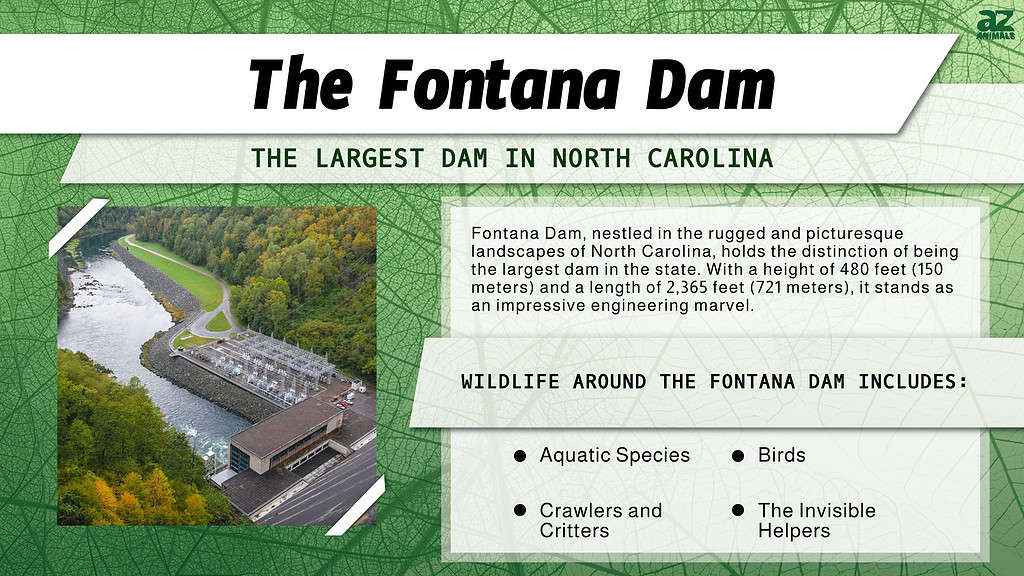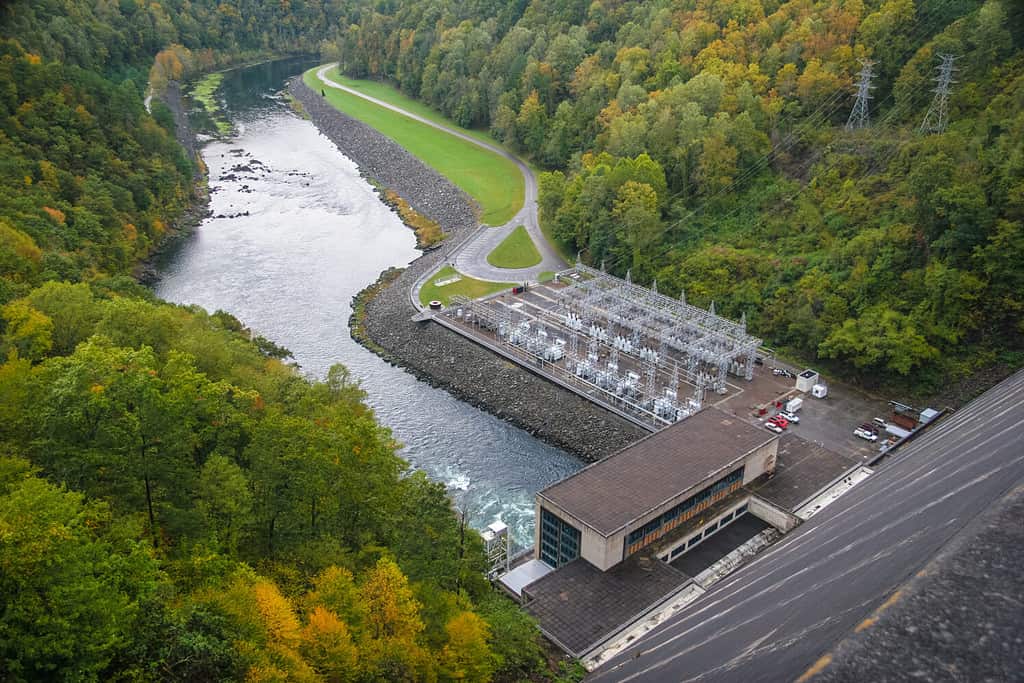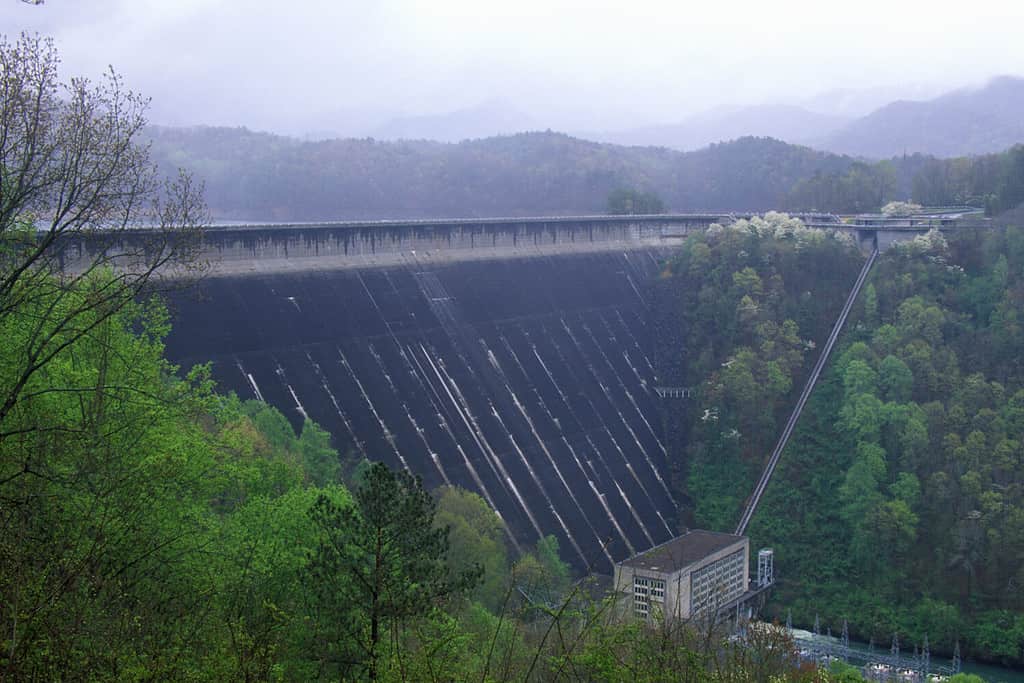
Welcome to the wonderful world of North Carolina’s dams. These marvels of engineering are not just imposing concrete and steel structures; they are lifelines that power homes, protect lands, and provide recreational opportunities.
Nestled among the state’s verdant forests, rolling mountains, and picturesque landscapes, these dams stand as silent custodians, playing an essential role in the everyday lives of North Carolinians.
From the towering heights of the Fontana Dam to the serene expanse of the Jordan Lake Dam, each dam has a unique story to tell. They are intertwined with the state’s history, have nurtured its growth, and are integral to its future.
Today, we discover the largest dam in North Carolina and ponder over a captivating scenario—what would happen if it ever broke? We’ll also peel back the layers of history, technology, and human effort that went into creating this incredible landmark. We’ll delve into the dam’s construction timeline, the techniques used to build it, and even the significant historical context in which it was created.

Fontana Dam is the largest dam in North Carolina.
©Arlene Waller/Shutterstock.com
The Largest Dam in North Carolina
Fontana Dam is the largest dam in North Carolina. Nestled in the rugged, picturesque landscapes of North Carolina, this dam isn’t just a marvel of engineering—it’s a testament to human ingenuity and our ability to harness nature’s power for our needs.
Ever driven past this colossal structure and wondered about its story? You’re not alone. From its massive concrete walls to the tranquil waters it holds back, every part of the Fontana Dam has a tale to tell.
Where Is Fontana Dam?
So, where exactly is the Fontana Dam? This towering structure stands tall in the beautiful landscapes of western North Carolina, in Graham and Swain counties, to be exact. If you’re familiar with the Great Smoky Mountains National Park or the bustling city of Knoxville, Tennessee, the dam is just a short drive away.
Where is Fontana Dam Located on a Map?
Now, if you’re a fan of scenic drives, the journey to Fontana Dam is a treat. You’ll find yourself winding through lush green forests, rolling hills, and charming small towns. But it’s not just about the destination here; the journey is equally enchanting!
Which Water Body is Fontana Dam In?
But a dam isn’t much without a body of water to tame, right? So that’s where the Tennessee River comes in. The Fontana Dam straddles this majestic river, creating the Fontana Lake.
The Tennessee River, one of the major tributaries of the Ohio River, begins its journey in the mountains of Tennessee, carving its way across several states. When it reaches the Fontana Dam, it’s held back to form a massive reservoir, which is a sight to behold!
The Fontana Lake, with its clear waters and serene setting, has become an iconic part of the local landscape. It’s a favorite spot for boating, fishing, and simply soaking in the beauty of nature.

The Fontana Dam straddles the majestic Tennessee River, creating the Fontana Lake.
©Vladimir Grablev/Shutterstock.com
Why Was Fontana Dam Built?
There’s a saying that goes, “Necessity is the mother of invention.” And that holds true when it comes to why the Fontana Dam was built. This monumental structure wasn’t just erected on a whim. Instead, it was born out of real needs, strategic goals, and a will to bring about positive change. So let’s dive into the ‘why’ behind this colossal construct.
Power Demand
The early 1940s was a pivotal time for the United States. The country was knee-deep in World War II, and the demand for aluminum, a crucial material for constructing aircraft, was skyrocketing. But there was a catch. The production of aluminum needed a lot of electricity. The Fontana Dam was seen as a solution to satiate this power-hungry industry. Its hydroelectric power plant could generate the much-needed electricity to help meet wartime production goals.
A Beacon of Economic and Social Change
While war efforts were a catalyst, the building of the Fontana Dam had broader implications. The rural communities in this part of North Carolina had long struggled with a lack of access to reliable electricity. The dam would not only bring light to these communities but also ignite economic development and improve the standard of living.
A Strategic Move
Building the Fontana Dam was also a strategic move during World War II. Positioned well inland, it was safe from any potential attacks on coastal power plants. In addition, it acted as a form of insurance, a backup source of power production that was relatively safe from the theater of war.
When Was Fontana Dam Built?
Let’s turn back the clock and take a trip down memory lane to see how the Fontana Dam was built. Picture this: it’s the early 1940s, WW2 is in full swing, and there’s a pressing need for electricity to support the war effort. This urgency sparked the beginning of the Fontana Dam’s journey.
Breaking Ground
In 1942, the first shovels hit the ground, marking the start of this ambitious project. It was a race against time, with the Tennessee Valley Authority (TVA) spearheading the construction. Thousands of workers were recruited, turning the quiet landscape into a buzzing hive of activity.

In 1942, the first shovels hit the ground, marking the start of this ambitious project.
©Joseph Sohm/Shutterstock.com
Building Up
For the next three years, these workers labored day and night, battling challenging weather conditions and tough terrain. Finally, they poured millions of tons of concrete, stacked one atop another, creating what would become the highest dam east of the Rocky Mountains.
The Final Stretch
By 1944, the dam was nearing completion. The finishing touches were being added, and the gates were almost ready to be closed. Then, in 1945, a milestone moment arrived. The dam was complete. The Tennessee River now had a new companion, the Fontana Lake, adding to its charm.
How Was Fontana Dam Built?
Ever looked at the Fontana Dam and thought, “How on earth was this built?” You’re not alone. The construction of this engineering marvel is an intriguing story of innovation, teamwork, and sheer willpower. Let’s dive in!
Mobilizing the Workforce
A project as massive as the Fontana Dam needed a mighty workforce. Thousands of workers from across the country were brought in. Engineers, builders, electricians—you name it, every skill was required. This diverse crew became the driving force behind the dam’s construction.
The Tools of the Trade
With the crew ready, it was time to bring in the heavy machinery. Bulldozers, cranes, and concrete mixers became a common sight at the construction site. Picture these machines working in harmony, moving earth, hoisting materials, and pouring concrete. It was a symphony of industry, playing a tune that slowly but surely built the dam.
Overcoming Obstacles
Building the dam was no walk in the park. Workers had to deal with challenging terrain, unpredictable weather, and the urgency of wartime construction. But they didn’t back down. They found innovative solutions, like building temporary railways for transporting materials and using state-of-the-art equipment to ensure safety and efficiency.
The Final Product
After three years of relentless work, the dam was complete. It stood tall, a testament to human ingenuity and determination. Next time you’re at the Fontana Dam, take a moment to appreciate the effort that went into its creation. Remember the story of the people who turned an ambitious idea into a towering reality.
Technical Specifications and Operation
Ever wondered about the inner workings of the Fontana Dam? How it holds back so much water, or how it generates electricity? Well, you’re in for a treat! Let’s delve into the nitty-gritty of this engineering wonder.

The Fontana Dam, at 480 feet tall, is the tallest dam in the Eastern United States.
©SUSAN LEGGETT/Shutterstock.com
The Nuts and Bolts
First off, the Fontana Dam is a big deal—literally. Standing at a whopping 480 feet tall and stretching 2,365 feet across, it’s the tallest dam in the Eastern United States. Imagine five Statue of Liberty stacked on top of each other—that’s how tall it is!
Built mainly of concrete, the dam’s massive size plays a key role in its ability to hold back the waters of the Tennessee River, creating the beautiful Fontana Lake.
Generating Power
Now, onto the exciting part—creating electricity. Deep within the dam, there are massive turbines. When water from the lake rushes through the dam, it spins these turbines. This spinning motion is converted into electricity by a generator. Think of it as a giant version of a hamster wheel powering a light bulb!
Once the electricity is generated, it doesn’t just stay at the dam. It’s sent out to the power grid, lighting up homes and powering industries across the region. The Fontana Dam has a big job, contributing a substantial amount of power to the Tennessee Valley area.
Controlling the Flow
The Fontana Dam doesn’t just generate power; it also helps control the flow of the Tennessee River. By managing the amount of water released from the dam, the TVA can prevent flooding downstream, especially during heavy rainfall.
Wildlife Found in Fontana Lake
Fontana Lake isn’t just a serene body of water; it’s a bustling metropolis of life, teeming with a variety of species. From the smallest insect to the largest fish, let’s dive beneath the surface and discover the wildlife that calls Fontana Lake home.

Ospreys have excellent vision that can detect underwater objects from the air, and they catch fish by diving underwater, either foot first or by submerging their whole bodies.
©BlueBarronPhoto/Shutterstock.com
Aquatic Species
Fontana Lake is a haven for a wide range of aquatic creatures. Several species of fish, such as smallmouth bass, walleye, and bluegill, thrive in these waters, making the lake a popular spot for anglers. But it’s not all about the fish; you’ll also find a variety of frogs, turtles, and even the occasional beaver taking a dip.
Birds
Look up from the water’s surface, and you might spot a plethora of bird species. Fontana Lake is a hub for both local and migratory birds. Ospreys and herons can often be seen diving for fish, while the surrounding forests echo the songs of warblers and woodpeckers. In addition, the lake provides a vital rest stop for migratory birds making their long journeys.
Crawlers and Critters
Don’t forget to check out the smaller critters too. Insects play a crucial role in the lake’s ecosystem. Water striders skim the surface while dragonflies dart and dance in the air. Beneath the surface, you’ll find a world of beetles, water bugs, and other tiny creatures that provide a vital food source for larger animals.
The Invisible Helpers
Last but certainly not least, we must mention the microscopic lifeforms that call Fontana Lake home. Algae, plankton, and a variety of other microscopic organisms form the base of the food chain. While they might not be visible to the naked eye, their role in the ecosystem is vital.
What Would Happen If the Fontana Dam Ever Broke?
It’s a bit unsettling to ponder, but have you ever wondered what would happen if the mighty Fontana Dam broke? While it’s an extremely unlikely scenario, thanks to stringent safety measures and regular maintenance, it’s an interesting question to explore. So, let’s dive into this hypothetical situation.

The dam breaking could lead to a catastrophic flood in the immediate area and could potentially affect communities downstream along the Tennessee River.
©MDay Photography/Shutterstock.com
A Rush of Water
If the dam were to break, the first thing that would happen is a tremendous release of water. Next, the Fontana Lake, currently held back by the dam, would surge downstream. This would lead to a catastrophic flood in the immediate area and could potentially affect communities downstream along the Tennessee River.
Power Disruptions
The Fontana Dam is a significant source of power for the region. If it were to fail, we would see immediate power disruptions. Power plants would need to ramp up production or tap into reserves to compensate for the lost electricity, which could lead to temporary outages.
Ecological Impact
The sudden release of water would also have a significant impact on local ecosystems. Fish, plants, and other wildlife could be adversely affected, and it might take years or even decades for these ecosystems to recover fully.
Safety Measures in Place
While it’s interesting to think about what could happen if the Fontana Dam broke, it’s important to remember that dams are designed with numerous safety measures in place. Regular inspections, constant monitoring, and ongoing maintenance work all ensure the dam remains safe and functional. In addition, in the unlikely event of a potential issue, there are protocols in place to address it quickly and effectively.
Key Takeaways
And just like that, we’ve reached the end of our journey exploring the mighty Fontana Dam. It’s been quite a ride, hasn’t it? We’ve traveled through time, dove deep into the dam’s construction, and uncovered its historical significance.
We’ve seen how this impressive structure has stood the test of time, serving as a powerhouse and a beacon of human determination. From its role in World War II to its impact on the local communities, this dam has truly made its mark.
As we wrap up, let’s not forget about the future. With ongoing conservation efforts and technological advancements, the Fontana Dam is all set to play a key role in the region’s future.
From a giant concrete structure in the heart of North Carolina, the Fontana Dam has grown to become a symbol of progress, community, and respect for nature.
The photo featured at the top of this post is © Melissa Rhnae Traub/Shutterstock.com
Thank you for reading! Have some feedback for us? Contact the AZ Animals editorial team.






